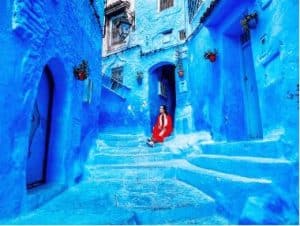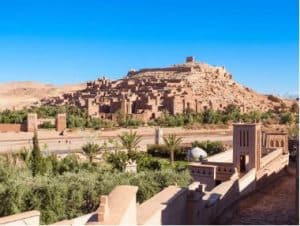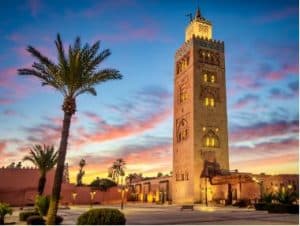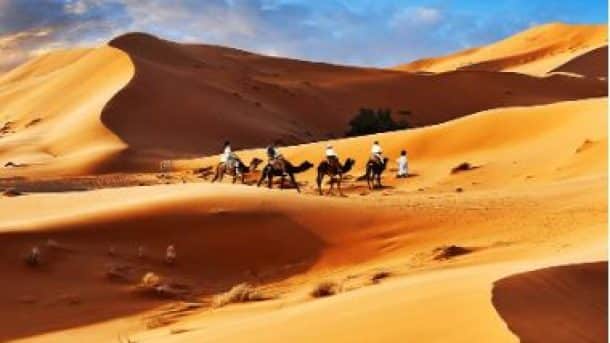Morocco is so close to Europe that, even though it seems like a world away, on a clear day you can see Spain from Tangier. After gaining independence from France in 1956, it has prospered as a self-assured and progressive Muslim country. Aside from the Spanish influence in the north, there are other cultural legacies that have persisted, such as the blue-turbaned Tuareg people who still roam the sand dunes of southern Africa, the history of the caravanserai, and the Berber heritage of Morocco’s indigenous groups, especially in the mountains.
Why it will be your favorite
Visiting what is undoubtedly one of the most different places on earth is made more enjoyable by this complex culture. With good cause, nearly 13 million foreign visitors arrived in Africa’s most popular travel destination in 2019. Fez, Marrakesh, Meknes, and Rabat are a series of imperial cities that were once the capitals of sultans. These cities are adorned with palaces, souqs, mosques, and elaborate madrasas, or religious schools. Their intricate historical layers and achingly picturesque streets never fail to captivate travelers.

Nevertheless, there are the Atlas Mountains, the Saharan desert camps, the quirky towns and villages of the northern Rif Valley, and the blue-and-white bohemian coastal retreats that run north-south.Another highlight is the artisan traditions that turn Morocco’s historic medinas into some of the top shopping destinations on earth. Another is the distinctive, subtly flavored Moroccan cuisine.
How to Proceed
Explore Marrakesh first, with its opulent hammams*, Djemaa el Fna street food*, and cutting-edge design shops, and then head to a poolside mudbrick oasis hotel nestled in the foothills of the High Atlas Mountains.Take a few days to hike to the villages in the Amazigh valley, go on an outdoor yoga retreat, or challenge yourself to the peak of North Africa’s highest mountain, Jebel Toubkal* (4,167m).
The Sahara route winds down through palm groves and crenellated ksars (fortified towns) to the rock formations and wide valley chasms of Todra, Dades, and Draa, which are ideal for leisurely excursions. The road crosses the snow-sprinkled Tizi n Tichka high mountain to reach the “Route of the Kasbahs.”
One of Morocco’s most alluring sights is the adjacent, Hollywood-famous ksar of Ait Ben Haddou*, which has appeared in shows like Game of Thrones and Lawrence of Arabia.

Take a camel ride to a desert tent and spend a memorable night beneath the Milky Way.
Wandering up at least one Saharan erg (dune) should be an obligatory part of any trip to Morocco. The largest area is the golden sea at Erg Chigaga, which is reachable from M’Hamid and peaks at a height of 30 meters; nevertheless, the more well-known Erg Chebbi, which is reachable from Merzouga, is as striking. Take a 4×4 or a camel ride to an Amazigh desert camp*, where you may spend a memorable night around open flames beneath the Milky Way.
After the Sahara, return via Marrakesh to Essaouira*, a bohemian walled fishing port that has gained enormous popularity for its high standards of tourist accommodations and laid-back, artistic atmosphere. Here, desert sands give way to beaches.
Wide, southerly beaches, many of which are blissfully deserted, generate some of the best winds for kitesurfing. In the last five years, Taghazout, a town of barefoot surfers, has seen a sharp increase in popularity. On the other hand, Agadir, Morocco’s sole significant beach resort town, is frequently preferred by families and package vacationers. It is flanked by the lush Souss Valley, where goats are known to climb argan trees.
It would be simple to travel through Morocco for a month without getting lost. Casablanca is a cosmopolitan city full of masterpieces from the art deco era. Travelers either love or loathe Fez’s medieval medina, which is one of the world’s most bewildering metropolitan areas. Because of its rich Fassi culinary history, it’s a popular location for cooking instruction. Not to be missed are the less-traveled imperial capitals of Meknes and Rabat; Meknes* is the ideal starting point for exploring the fascinating pilgrimage village of Moulay Idriss and the Roman remains of Volubilis.
Where to lodge
One of Morocco’s most notable attributes is the variety of hotels in the nation. They range from five-star palatial multinational chains and historic boutique medina riads to yoga retreats by the sea, luxurious mountain lodges in the High Atlas (home of Richard Branson’s opulent Kasbah Tamadot*), and straightforward rural B&Bs.
Just as the beach bungalow is synonymous with Thailand, so too is the riad with Morocco. A lush outdoor patio with a central fountain is a key element of this classically Islamic-inspired design. For hundreds of years, medina living in Moroccan cities has been dominated by this traditional way of living.
Many of them have been renovated and are now stunning boutique hotels that range in opulence. Beside incredible riad palaces costing hundreds of pounds, you can discover quaint backpacker riads with dorm rooms for less than £20 a night.
These hotels showcase some of the best examples of traditional Moroccan workmanship, including intricately carved cedarwood doors, painted beamed ceilings, elaborate plasterwork, and an abundance of zellij tiles featuring Islamic geometric designs. There are riads with rooftop pools, tiny hammas, and personal chefs. Staying in one offers a unique perspective on the inner workings of the medina. The best can be found at Fez and Marrakesh.
For those seeking sun in the winter, there are also plenty of great country hotels with pools, most of which offer full board. Another distinctive aspect of the Moroccan hotel scene are the kasbah hotels* along the path from Marrakesh to the Sahara desert, some of which are exceptional five-star establishments. The once-in-a-lifetime experiences at the (very modest) Saharan desert camps at Erg Chebbi and Erg Chigaga should be on your bucket list. Private luxury villas could be a more cost-effective choice for big parties.

Avoid missing
For those who are eager to experience a vacation without flying, the northwest coast of Morocco offers a great substitute destination to the well-known attractions of Marrakesh. A direct boat from Tarifa, Spain, to Tangier may be taken there.The new Al Boraq high-speed train from Casablanca makes the area even more accessible, taking visitors to Tangier in little over two hours.
Even though Tangier had a negative reputation for bother and small-time crime in the early 2000s, due to the major growth of the adjacent Tanger Med 2 port, money has rushed into this old favorite haunt of the Beat generation during the past five years. The first five-star riad in the city opened its doors in 2019, and the seafront kasbah and medina have been renovated.
In Tangier, take a cue from authors and musicians.
Take the bus or a fancy taxi down to the mural-washed white village of Asilah after doing some café hopping in Tangier like writers and rock stars did. Asilah is a coastal art mecca with 15th-century fortifications tumbling into the Atlantic and has a mood comparable to Essaouira, but with less crowds.
You may head inland from Asilah to the cool settlements of the Rif Valley. The Instagram crowd’s favorite spot is Chefchaouen*, with its slow-moving blue beauty cascading down a hillside. Tetouam is another place worth visiting; it’s equally enticing yet sometimes disregarded. Surrounded by a Unesco-listed old medina, this former capital of Morocco’s Spanish Protectorate (1912–1956) is one of the leading artistic hubs of the nation.
Ideal time to go
Morocco’s inland cities are best avoided in July and August due to the unbearably hot temperature; the ideal months for nice, warm weather are March through June and September through November.
Frequently Asked Questions
Is safety a priority in Morocco?
Indeed, without a doubt. Popular places like Marrakesh and Fez have dedicated tourist police who understand English and are available to assist you if you run into any problems. The main issue you can encounter in the medina’s back streets is pickpocketing. It’s advisable to keep your possessions close to hand and avoid showing off your phone around the souqs. Younger women may occasionally experience catcalling and light harassment in locations like Marrakesh and Fez, but traveling in Morocco alone is as safe as it gets.
In Morocco, where should I avoid going?
Hiking in isolated mountain regions should never be done alone. Instead, go with a certified guide who will ensure that your path goes through welcoming villages. It’s advisable to avoid meandering through sleepy medina backstreets at night in any major city.
Is Morocco a costly country?
In general, Morocco is neither as cheap as Asia nor as expensive as Europe or North America. Prices for meals and lodging in Marrakesh are comparable to those in many other European towns, but they decrease considerably outside of the busiest tourist areas. Even in Marrakesh, you can get a good meal for less than £20 per person. Private conveyance may be costly.
Morocco’s Currency
Moroccan dirham





